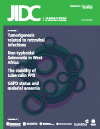Laboratory diagnosis of human brucellosis in Egypt and persistence of the pathogen following treatment
DOI:
https://doi.org/10.3855/jidc.1538Keywords:
Brucellosis, lateral flow assay, PCR, treatmentAbstract
Introduction: Brucellosis is a major public health problem in Egypt. The Brucella IgM/IgG lateral flow assay was developed as a point-of-care test for the diagnosis of human brucellosis. The aim of this study was to assess the diagnostic value of the lateral flow assay for use in Egypt.
Methodology: Fifty samples of patients who presented with clinical suspicion of brucellosis over a one-year period were collected. All samples were subjected to the Brucella IgM/IgG lateral flow assay, serum agglutination test (SAT), rose bengal RB Test (RB), 2- mercapteoethanol (2-ME), culture and PCR. SAT, 2- ME, culture and PCR were retested after the end of the treatment.
Results: Culture and SAT confirmed the diagnosis of brucellosis in twenty patients. While 90% of the samples were positive by SAT, only 30% and 85% were positive by culture and PCR respectively. The sensitivity of the lateral flow assay calculated for the Brucella IgM/IgG was 95% and specificity was 97%.
Conclusion: These data show that the lateral flow assay is more suitable for diagnosis of brucellosis in Egypt than culture and SAT. Application of the PCR on serum samples collected during follow-up revealed that the DNA of the pathogen was yet not completely cleared almost 60 days after the start of treatment with doxycycline and ciprofloxacin.
Downloads
Published
How to Cite
Issue
Section
License
Authors who publish with this journal agree to the following terms:
- Authors retain copyright and grant the journal right of first publication with the work simultaneously licensed under a Creative Commons Attribution License that allows others to share the work with an acknowledgement of the work's authorship and initial publication in this journal.
- Authors are able to enter into separate, additional contractual arrangements for the non-exclusive distribution of the journal's published version of the work (e.g., post it to an institutional repository or publish it in a book), with an acknowledgement of its initial publication in this journal.
- Authors are permitted and encouraged to post their work online (e.g., in institutional repositories or on their website) prior to and during the submission process, as it can lead to productive exchanges, as well as earlier and greater citation of published work (See The Effect of Open Access).








